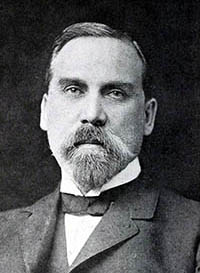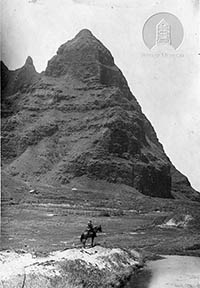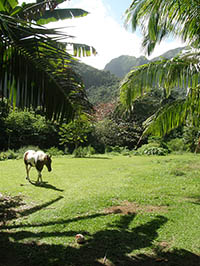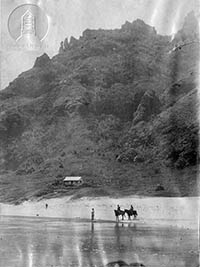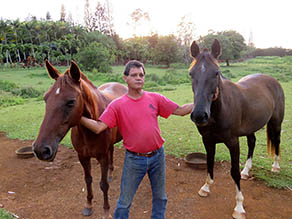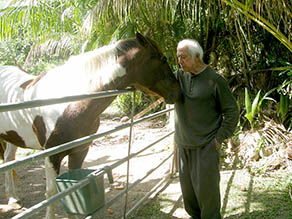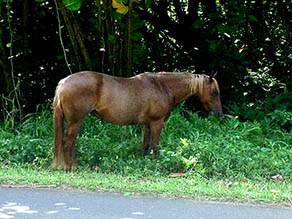 |
 |
 |
 |
||||||
|
|
|
|
|
|
|
|
|
|
 |
 |
||
 |
|
|
 |
 |
 |
 |
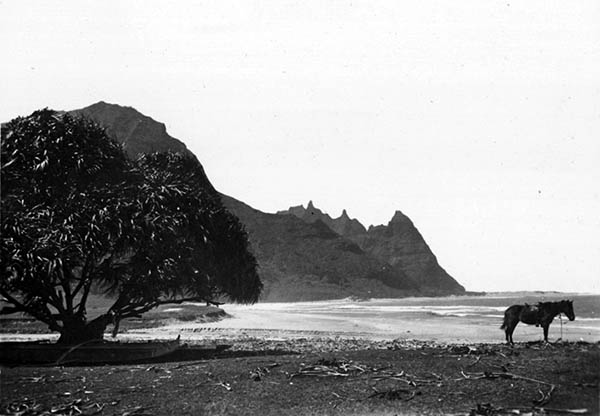
|
 |
 |
“The Robinsons are a family originally from Scotland having large landholdings in Hā‘ena,” Carlos explains, “and considerable acreage of the west side of Kaua‘i. The family purchased the entire island of Ni‘ihau in the mid-1800s, In Halele‘a, they ran cattle in Hā‘ena, Wainiha, Lumaha‘I, and Waipā, as well as in several valleys in the Nā Pali district.” “Robinson owned their land,” Makaala adds, “so they were paniolo out there, they were working for Robinson. So when you talked about all the cattle days and so forth and paniolo, they were all working for Robinson.” “In Limahuli, we had cows EVERYWHERE,” Samson recalls, “to the side here, to the top where you cannot go. All inside there, to the left had spring water, where the Nou stay, and then a trail come over on top of Wichman. Everybody ride horse. Every trail in there we used to walk. My dad used to keep his Kalalau horse in there, he had one horse he called Spark—one-man horse. “That was our car. When I was growing up, my mother would go squidding, jump on the horse and I would sit on her neck. Go down over the pine trees after the park. Tie the horse there, stay with the horse underneath the trees, and she would be squidding all along there. They never did drive, they never care to learn how to drive. Never had no place to go, huh? “Main road was paved, but not this fine kind; big kind rock under here and tar. They had tar, but had more pot holes than anything else. Was a slow process, all this road. Yeah, I saw big rocks, and then when we were older it was improving. By the time I got married the roads was getting better. That’s the progression.” “I tell you, when I was young, I used to walk taro from end of the road. That’s where my uncle Kalei was, and then my uncle Jacob had the poi mill. So that’s all what he did, the stallion. And they put me on top. But the horse did everything, I never had to do nothing. They load me up, they load the taro and put me on—regular saddle—with full bag of taro on top, big—just throw ‘em on the horse, put me on. And when they unload, I come right by the window, right by the kitchen. The old lady see you, they come out, pull me off, huli the bag, put me back, I take the horse back.” “I know one time I went down there where Gordie used to live, and two horses were there. My dad and my uncle were planning to go in. And my dad used to always tell us, when had people in there, ‘You take in what you get and you get Kalalau horses.’ So if you like send out something, you put ‘em on the Ha‘ena horse. But if you went in, you gotta send something out, these people gotta send something out, they just put ‘em on the other horse, Ha‘ena horse, and let ‘em go, and he work his way out. And then the same thing you do: when you come home, you like send something, you take Kalalau horse, just put on, he go back home.” “I’m not afraid of not knowing where the water source is. I’m not one for go carry canteen. All my life I go in Kalalau, I don’t take no water. Because right around the next turn there’s a stream right here. So this is the safest place for me. That’s what I want. Anytime you thirsty, let’s go to the next turn or stuff like that. It’s the happy way to get around here.” “I drove pipi [beef cattle] out of Hanakāpī‘ai. In Kalalau they used to have the sampans, or they had one WWII landing craft. That’s how they used to bring em out. From Honokoa, they lead the cows to Kalalau, that’s what they do. “My uncle Simeon used to tell us all where the rest stops on the trail, when they used to come out and go back and forth. So the only place we walk was just before you reach reach Hololo big stone, just outside before you go in through the hala, that thing you gotta climb over there—the rocks, they so small, sometimes kinda slippery. But the horse wen usually walk on the edge, that’s where there’s the best footing. So my old man told me, ‘Whatever the horse do, you give him free, make sure the bridle free, and you open your leg from the right stirrup, in case you fall over.’ So you just ride in like that, and the horse just take over. When I was green—I was new—they told me everything what for do. Make sure your right feet lose, if the horse go over, let him go over. “With our kind thinking, to bring out cows, easy. How I did mine is, I took the cow in heat, I took ‘em in. I never really think of rope, the first one I took in, ahh, that thing died. I nevah did train ‘em well with the rope. (it hung itself) Took in one more, take ‘em inside, leave ‘em with the bull about a month, then I went in chase ‘em. The bull knew enough so he wasn’t going trouble, was going stay with ‘em, and she was fresh enough so beat the trail. But after put the bull from Hanakapena on the trail, cause if the cows stop, jam up, he going fight back, but if they gone, he gonna fight for them. So I kinda hard time. “Wild, the cows were—wild. Came out of Ha‘ena, they went up the cave and stayed, all that guava, they went up to the top and hide in there. That was something. I went in at night, they were all down with the cows. I take cows out there with the calves, and I catch tie ‘em up, chase all the cows, mix ‘em up, come straight home. Went right in the corral. We didn’t check. The next day I went back, I put the rope on top. “He tough friends, that bull. I make ‘em think, when we butcher that bugger, was 800 pounds—was heavy! This fellow, he’s just go to Hanakapi‘ai, eh? Cause, a couple of calves, when they were nailing the stray animals. The cops were fining us for stray cattle on the road, so I throw all mine on the trail, everybody going wild. Got ‘em on the trail. Then six went missing. Well they went in, and gave birth and everything else, and I nevah know. I figure they fell over, cause I nevah could track them going in. Until one year, Kaipo and I were going in with Rex Glasier, I think, right where you cross Hanakapi‘ai, start to zig-zag, I saw the ti leaf eaten little bit further inside than the trail. Ohh, that caught my eye! I look around, ‘Ehh, little bit more,’ I came back, I went ride straight inside there. Saw more eaten up, figure ‘Oh, that’s cows.’ So never bother going up. The next day I went back in, walk slowly all over, try to find them… “Fat, fat! And then I look, ‘Oh, strange colors!’ So, those guys were in there, and the cows that I recognize, they were all nice, but they had some strange ones that was born in there—this bull who was born in there too! That’s how long the cows ran away, stayed in, and they gave birth, and these guys, I never know—no idea. Afterwards, I throw animals inside, and then the state guys were checking up, so I figure if they come too often, they must have seen the brand. So they came to see me, I said ‘Ahh, if you see anything inside there, you keep ‘em!’ “We used to ride horses into Kalalau to go hunt goat,” Kelii says. “None of this walking, you know. Everything is all horseback and that’s why I say, the horse was my bicycle in those days. We were walking on the street, we wanted to go a certain area, we saw a horse on the side of the road, and we could catch them. There was this vine—koali, the morning glory vine that grew on the beach—very strong. We used to go break a piece of that vine and use it for rope. And we could see the horse, we catch the horse and we ride them to where we want to go and we turn them loose. So the horse was a very important transportation for us. “Riding horses was my hobby,” Samson relates. “I just loved to catch anything, and I wanted to ride them. So when we were kids, we had a lot of horses roaming here. I tried to catch the young ponies first. They will follow you everywhere you go until you’re tired. That was my love. "And then I always think about what my next challenge was. Okay, you get a wild cattle. I always tell myself ‘Well, if the pineapple canneries were working now, I’d buy that feed and just stick them up there and feed the animals. And then wait until the drought comes in.’ If you’re going to feed, get above there and then you put them in areas that you want, or wherever they frequent the best: feed them. Tell all the hunters, they go get the pigs. "See, once the cows know the grain, when they no more nothing to eat, they’ll be there. Also the pigs. So all the pig hunters let them know, you feed them. Don’t harass the cattle, but take all the pigs. See, anytime you hunt you got to make friends with people who frequent there. “I would feed them, I would feed them and then look for a place where you can wall up, or make one place for when you want them, then you put some gates up. But with the wild cattle, you’re going to have to make your wires close enough so maybe only the nose can go in. If the head can go in, they’ll break anything. “I was raising cattle just for rodeo. I love that sport, where you can exert yourself and test your balance, and test your speed and test your heart, you know. I just love it, because you just got to get all those reflexes, and the eyes see, the body do. “I rodeo all my life, I just stopped rodeo,” Kelii says. “My last rodeo competition was in 1989—over here, it was a state rodeo, and that was my last competition rodeo. My stepdad, Samson—which I take him as my Dad—taught me a lot about horses, mountain, cattle. His job at the ranch was to train the young horses to make them work cattle. When the ranch closed, he took the test to be a fireman. And that guy man, he was awesome!” “So when I went rodeo,” Samson continues, “I went with Kaipo Chandler, one day he asked me, ‘Sam, you want to go rodeo?’ ‘Yeah, yeah, yeah!’ ‘Go with me.’ Boy, he come down, Francis—that’s his brother—they would come down, see me training these damn ugly Hawaiian horse. And everybody laugh because it looked like one toy, yeah? but I say, ‘Well, then I gotta go make one name for this Hawaiian horses. Give them one name.’ And that’s all I had is the Hawaiian horses. Afterwards I always took new horse—any kind rodeo, I took a new horse. But when I go Honolulu I get my favorites, I always use them. You can truss them, load and they’re quiet. And that’s all my rescue horses. You know I can trust put people on, they not going to rattle. Use them any time, any place.” Read about horseback rescues on the Kalalau Trail.
|
 |
 |
Horse and Cattle days came slowly to the end with the break-up of the Hui and the transformation of the Hui lands into private property. This partition set Hā‘ena on a new course.
|
 |
||
 |
|
 |
||

|
|
||||
| Copyright 2018 Pacific Worlds & Associates • Usage Policy • Webmaster |
||||
